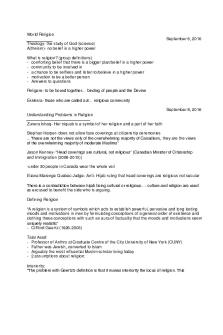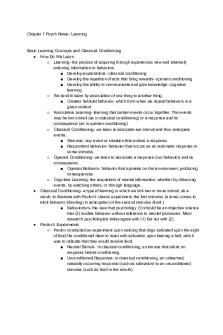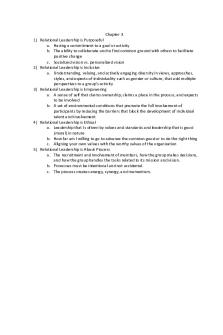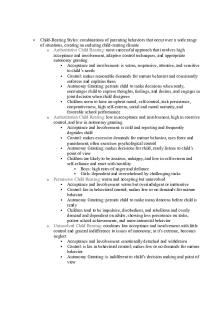Chapter 7 - Summary Exploring Psychology PDF

| Title | Chapter 7 - Summary Exploring Psychology |
|---|---|
| Course | Intro to Psychology 111 |
| Institution | Binghamton University |
| Pages | 5 |
| File Size | 59.8 KB |
| File Type | |
| Total Downloads | 115 |
| Total Views | 159 |
Summary
Notes...
Description
Chapter 7 Psych Notes- Learning
Basic Learning Concepts and Classical Conditioning ● How Do We Learn ○ Learning- the process of acquiring through experiences new and relatively enduring information or behaviors. ■ Develop expectations- classical conditioning ■ Develop the repetition of acts that bring rewards- operant conditioning ■ Develop the ability to communicate and gain knowledge- cognitive learning ○ We tend to learn by association of one thing to another thing. ■ Creates habitual behavior, which form when we repeat behaviors in a given context. ○ Associative Learning- learning that certain events occur together. The events may be two stimuli (as in classical conditioning) or a response and its consequence (as in operant conditioning) ○ Classical Conditioning- we learn to associate two stimuli and thus anticipate events. ■ Stimulus- any event or situation that evokes a response. ■ Respondent Behavior- behavior that occurs as an automatic response to some stimulus. ○ Operant Conditioning- we learn to associate a response (our behavior) and its consequence. ■ Operant Behavior- behavior that operates on the environment, producing consequences. ○ Cognitive Learning- the acquisition of mental information, whether by observing events, by watching others, or through language. ● Classical Conditioning- a type of learning in which we link two or more stimuli; as a result, to illustrate with Pavlov’s classic experiment, the first stimulus (a tone) comes to elicit behavior (drooling) in anticipation of the second stimulus (food.) ■ Behaviorism- the view that psychology (1) should be an objective science that (2) studies behavior without reference to mental processes. Most research psychologists today agree with (1) but not with (2). ● Pavlov’s Experiments ○ Pavlov conducted an experiment upon noticing that dogs salivated upon the sight of food.He conditioned them to react with salivation upon hearing a bell, which was to indicate that they would receive food. ■ Neutral Stimuli- In classical conditioning, a stimulus that elicits no response before conditioning. ■ Unconditioned Response- in classical conditioning, an unlearned, naturally occurring response (such as salivation) to an unconditioned stimulus (such as food in the mouth)
■
○
○
●
Unconditioned Stimulus- in classical conditioning, a stimulus that unconditionally--- naturally and automatically--- triggers an unconditioned response. ■ Conditioned Response- classical conditioning, a learned response to a previously neutral (but now conditioned) stimulus. ■ Conditioned Stimulus- in classical conditioning, an originally neutral stimulus that, after association with an unconditioned stimulus (US), comes to trigger a conditioned response. Acquisition- in classical conditioning, the initial stage, when one links a neutral stimulus and an unconditioned stimulus so that the neutral stimulus begins triggering the conditioned response. In operant conditioning, the strengthening of a reinforced response. ■ “Classical conditioning is biologically adaptive because it helps humans and other animals prepare for good or bad events.” ■ Higher-Order Conditioning- a procedure in which the conditions stimulus in one conditioning experience is paired with a new neutral stimulus, creating a second (often weaker) conditioned stimulus. ● For example, an animal that has learned that a tone predicts food might then learn that a light predicts the tone and begin responding to the light alone. ○ NS= Neutral Stimulus ○ US_ Unconditioned Stimulus ○ UR- Unconditioned Response ○ CS- Conditioned Stimulus ○ CR- Conditioned Response
Extinction and Spontaneous Recovery ■ Extinction- the diminishing of a conditioned response; occurs in classical conditioning when an unconditioned stimulus (US) ■ Spontaneous Recovery- the reappearance, after a pause of an extinguished conditioned response. ○ Generalization- the tendency, once a response has been conditioned, for stimuli similar to the conditioned stimulus to elicit similar responses. (In operant conditioning, generalization occurs when responses learned in one situation occur in other similar situations.) ■ Toddlers who are taught to be afraid of moving cars are also afraid of moving trucks and motorcycles. ○ Discrimination- in classical conditioning, the learned ability to distinguish between a conditioned stimulus and similar stimuli that do not signal an unconditioned stimulus. (In operant conditioning, the ability to distinguish responses that are reinforced from similar responses that are not reinforced.) Pavlov’s Legacy
■
Many other stimuli can be classically conditioned in many other organisms. ■ Pavlov showed us how a process such as learning can be studied objectively. ○ Applications of Classical Conditioning ■ Drug Cravings- Former drug users often feel a craving when they are again in the drug-using context ■ Food Cravings- Classical conditioning makes dieting difficult. ■ Immune Responses- Classical conditioning even works on the body’s disease-fighting immune system. Operant Conditioning- a type of learning in which a behavior becomes more likely to recur if followed by a reinforcer or less likely to recur if followed by a punisher. ● Skinner’s Experiments ○ Law of Effect- Thorndike’s principle that behaviors followed by favorable consequences become more likely, and that behaviors followed by unfavorable consequences become less likely. ■ Reinforcements- in operant conditioning, any event that strengthens the behavior it follows. ● Shaping Behavior ○ SHaping- an operant conditioning procedure in which reinforcers guide behavior toward closer and closer approximations of the desired behavior. ■ Help us understand what nonverbal organisms can distinguish without language. ● Type of Reinforcers ■ Positive Reinforcement- increasing behaviors by presenting positive reinforcers. A positive reinforcer is any stimulus that, when presented after a response, strengthens the response. ■ Negative reinforcement- increasing behaviors by stopping or reducing negative stimuli. A negative reinforcer is any stimulus that, when removed after a response, strengthens the response. ● Negative Reinforcement is not punishment; it removes a punishing event ○ When a kid whines, the parents give in to their requests to do something. ○ Primary and Conditioned Reinforcers ■ Primary Reinforcers- an innately reinforcing stimulus, such as one that satisfies a biological need. ■ Conditioned Reinforcers- a stimulus that gains its reinforcing power through its association with a primary reinforcer; also known as a secondary reinforcer. ○ Immediate and Delayed Reinforcers
■
●
●
During experiments, if the subject (animal) is not rewarded immediately within 30 seconds of the stimulus, they will not learn to be conditioned to that stimulus. However, humans do respond to delayed responses Reinforcement Schedules- a pattern that defines how often a desired response will be reinforced ○ Continuous Reinforcement- reinforcing the desired response it occurs. ○ Partial reinforcement schedules■ Resistance to extinction is what drives animals to pursue a behavior and response without continuous reinforcement. ■ Partial (intermittent) reinforcement schedule- reinforcing a response only part of the time; results in slower acquisition of a response but much greater resistance to extinction than does continuous reinforcement. ■ Fixed-ratio schedules- in operant conditioning, a reinforcement schedule that reinforces a response only after a specified number of responses. Punishment- an event that tends to decrease the behavior that follows it. ○
○
●
Type of Punisher
Description
Examples
Positive Punishment
Administer an aversive stimulus
Spray water on a barking dog;give a traffic ticket for speeding
Negative Punishment
Withdraw a rewarding stimulus
Take away a misbehaving teen’s driving privileges.
Downsides to physical punishments ■ Punished behavior is suppressed, not forgotten. This temporary state may (negatively) reinforce parent’s punishing behaviors. ■ Punishment teaches discrimination among situations. ■ Punishment can teach fear. ■ Physical punishment may increase aggression by modeling violence as a way to cope with problems. Applications of Operant Conditioning ○ At School ○ In Sports ○ At Work ○ In Parenting ○ To Change Your Own Behavior ■ State a realistic goal in measurable terms and announce it. ■ Decide how, when, and where you will work toward your goal. ■ Monitor how often you engage in your desired behavior. ■ Reinforce the desired behavior ■ Reduce the rewards gradually
● Contrasting Classical and Operant Conditioning Biology, Cognition, and Learning ● Biological Constraints on Conditioning ○ Not every behavior can be trained through conditioning ● Biological Limits on Classical Conditioning ○ Preparedness- a biological predisposition to learn associations, such as between taste and nausea, that have survived value. ■ Our preparedness to associate a CS with a US that follows predictably and immediately is adaptive. ● Biological Limits on Operant Conditioning ○ Biological constraints predispose organisms to learn associations that are naturally adaptive. ○ Instinctive Drift- the tendency of learned behavior to gradually revert to biologically predisposed patterns. ● Cognitions Influence on Conditioning ○ Cognition and Classical Conditioning ○ Cognition and Operant Conditioning ■ Cognitive map- a mental representation of the layout of one’s environment. For example, after exploring a maze, rats act as if they have learned a cognitive map of it. ■ Latent Learning- learning that occurs but is not apparent until there is incentive to demonstrate it. ● ‘Learning By Observation ○ Mirrors and Imitation in the Brain ○ Applications of Observational Learning ■ Prosocial Effects ■ Antisocial Effects...
Similar Free PDFs

Chapter 7 psychology
- 4 Pages

Psychology: Chapter 7, Learning
- 5 Pages

Exploring World Religions Summary
- 19 Pages
Popular Institutions
- Tinajero National High School - Annex
- Politeknik Caltex Riau
- Yokohama City University
- SGT University
- University of Al-Qadisiyah
- Divine Word College of Vigan
- Techniek College Rotterdam
- Universidade de Santiago
- Universiti Teknologi MARA Cawangan Johor Kampus Pasir Gudang
- Poltekkes Kemenkes Yogyakarta
- Baguio City National High School
- Colegio san marcos
- preparatoria uno
- Centro de Bachillerato Tecnológico Industrial y de Servicios No. 107
- Dalian Maritime University
- Quang Trung Secondary School
- Colegio Tecnológico en Informática
- Corporación Regional de Educación Superior
- Grupo CEDVA
- Dar Al Uloom University
- Centro de Estudios Preuniversitarios de la Universidad Nacional de Ingeniería
- 上智大学
- Aakash International School, Nuna Majara
- San Felipe Neri Catholic School
- Kang Chiao International School - New Taipei City
- Misamis Occidental National High School
- Institución Educativa Escuela Normal Juan Ladrilleros
- Kolehiyo ng Pantukan
- Batanes State College
- Instituto Continental
- Sekolah Menengah Kejuruan Kesehatan Kaltara (Tarakan)
- Colegio de La Inmaculada Concepcion - Cebu












